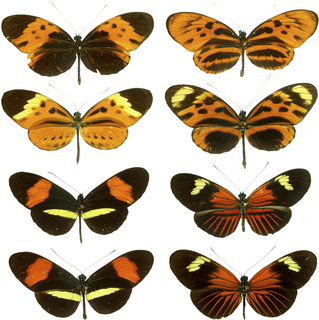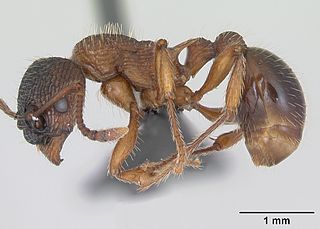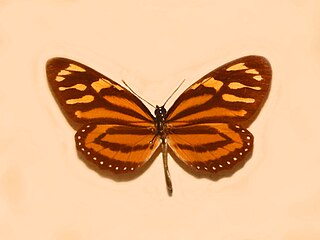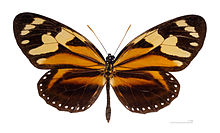
Danainae is a subfamily of the family Nymphalidae, the brush-footed butterflies. It includes the Daniadae, or milkweed butterflies, who lay their eggs on various milkweeds on which their larvae (caterpillars) feed, as well as the clearwing butterflies (Ithomiidae), and the tellervini.

In evolutionary biology, mimicry is an evolved resemblance between an organism and another object, often an organism of another species. Mimicry may evolve between different species, or between individuals of the same species. Often, mimicry functions to protect a species from predators, making it an antipredator adaptation. Mimicry evolves if a receiver perceives the similarity between a mimic and a model and as a result changes its behaviour in a way that provides a selective advantage to the mimic. The resemblances that evolve in mimicry can be visual, acoustic, chemical, tactile, or electric, or combinations of these sensory modalities. Mimicry may be to the advantage of both organisms that share a resemblance, in which case it is a form of mutualism; or mimicry can be to the detriment of one, making it parasitic or competitive. The evolutionary convergence between groups is driven by the selective action of a signal-receiver or dupe. Birds, for example, use sight to identify palatable insects, whilst avoiding the noxious ones. Over time, palatable insects may evolve to resemble noxious ones, making them mimics and the noxious ones models. In the case of mutualism, sometimes both groups are referred to as "co-mimics". It is often thought that models must be more abundant than mimics, but this is not so. Mimicry may involve numerous species; many harmless species such as hoverflies are Batesian mimics of strongly defended species such as wasps, while many such well-defended species form Mullerian mimicry rings, all resembling each other. Mimicry between prey species and their predators often involves three or more species.

Swallowtail butterflies are large, colorful butterflies in the family Papilionidae, and include over 550 species. Though the majority are tropical, members of the family inhabit every continent except Antarctica. The family includes the largest butterflies in the world, the birdwing butterflies of the genus Ornithoptera.

Batesian mimicry is a form of mimicry where a harmless species has evolved to imitate the warning signals of a harmful species directed at a predator of them both. It is named after the English naturalist Henry Walter Bates, after his work on butterflies in the rainforests of Brazil.

The viceroy is a North American butterfly that ranges through most of the contiguous United States as well as parts of Canada and Mexico. The westernmost portion of its range extends from the Northwest Territories along the eastern edges of the Cascade Range and Sierra Nevada mountains, southwards into central Mexico. Its easternmost range extends along the Atlantic and Gulf coasts of North America from Nova Scotia into Texas.

Müllerian mimicry is a natural phenomenon in which two or more unprofitable species, that may or may not be closely related and share one or more common predators, have come to mimic each other's honest warning signals, to their mutual benefit, since predators can learn to avoid all of them with fewer experiences. It is named after the German naturalist Fritz Müller, who first proposed the concept in 1878, supporting his theory with the first mathematical model of frequency-dependent selection, one of the first such models anywhere in biology.

The Magical Mimics in Oz (1946) is the thirty-seventh in the series of Oz books created by L. Frank Baum and his successors, and the first written by Jack Snow. It was illustrated by Frank G. Kramer. The book entered the Public Domain in the United States, when its copyright was not renewed as required.

Hypolimnas is a genus of tropical brush-footed butterflies commonly known as eggflies or diadems. The genus contains approximately 23 species, most of which are found in Africa, Asia, and Oceania. One species, the Danaid eggfly, is noted for its exceptionally wide distribution across five continents; it is the only Hypolimnas species found in the Americas.

Papilio polytes, the common Mormon, is a common species of swallowtail butterfly widely distributed across Asia.

The queen butterfly is a North and South American butterfly in the family Nymphalidae with a wingspan of 70–88 mm (2.8–3.5 in). It is orange or brown with black wing borders and small white forewing spots on its dorsal wing surface, and reddish ventral wing surface fairly similar to the dorsal surface. The ventral hindwings have black veins and small white spots in a black border. The male has a black androconial scent patch on its dorsal hindwings. It is found throughout the tropics and into the temperate regions of the Americas, Asia and Africa. It can be found in meadows, fields, marshes, deserts, and at the edges of forests.

The Danaini are a tribe of brush-footed butterflies. Their type genus Danaus contains the well-known monarch butterfly and is also the type genus of the tribe's subfamily, the milkweed butterflies (Danainae).

Ithomiini is a butterfly tribe in the nymphalid subfamily Danainae. Some authors consider the group to be a subfamily (Ithomiinae). These butterflies are exclusively Neotropical, found in humid forests from sea level to 3000 m, from Mexico to Argentina. There are around 370 species in some 40–45 genera.

Lieinix is a genus of butterflies in the subfamily Dismorphiinae. It is native to the Americas.

Lycorea halia, the tropical milkweed butterfly, is a species of nymphalid butterfly in the Danainae subfamily. It is found from Peru to the Caribbean and Mexico. Strays can be found as far north as Texas. The habitat consists of rainforest.

Eueides isabella, the Isabella's longwing or Isabella's heliconian, is a species of nymphalid butterfly, belonging to the Heliconiinae subfamily.

Myrmica schencki is a species of ant in the genus Myrmica.

Lycorea halia halia, the tropical milkweed butterfly, is a subspecies of Lycorea halia, also called the tropical milkweed butterfly, a nymphalid butterfly in the Danainae subfamily. It is found from Suriname, French Guiana and Peru to the Caribbean. Its habitat is tropical rainforest.

Lycorea halia cleobaea, the tropical milkweed butterfly, is a subspecies of Lycorea halia, also called the tropical milkweed butterfly, a nymphalid butterfly in the Danainae subfamily. It is found from the Antilles, Dominican Republic and the Caribbean. Its habitat is the tropical rainforest.

Lycorea halia atergatis, the tropical milkweed butterfly, is a subspecies of Lycorea halia, also called the tropical milkweed butterfly, a nymphalid butterfly family in the Danainae subfamily. It is found from Mexico, Venezuela and Colombia. Its habitat is tropical rainforest. It is sold commercially to collectors.
















